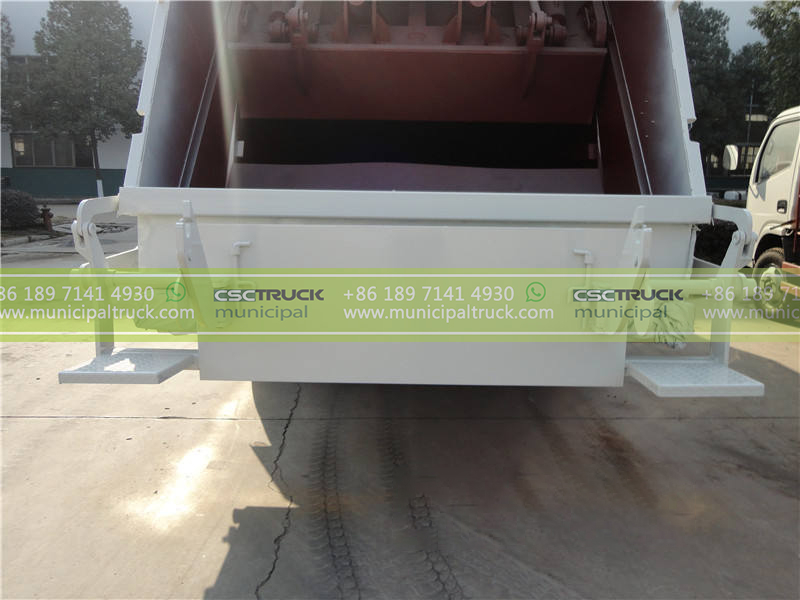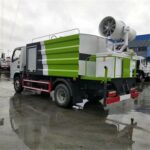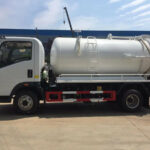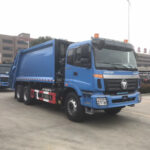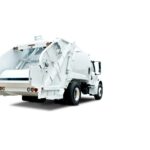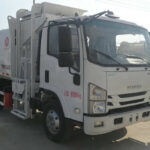The Mounting Problem: Landfill Space as a Scarce Urban Resource
The relentless stream of waste generated by modern urban life poses one of municipal management’s most persistent challenges: dwindling landfill capacity. Acquiring new landfill sites near population centers is increasingly fraught with environmental concerns, astronomical costs, fierce community opposition (“NIMBYism”), and stringent regulatory hurdles. Simultaneously, the operational expenses associated with running existing landfills – including leachate management, methane gas capture, daily cover soil, and long-term monitoring – place significant burdens on municipal budgets. Extending the functional lifespan of current facilities isn’t just a financial imperative; it’s a critical element of sustainable waste management strategies. In this high-stakes scenario, the ubiquitous compactor garbage truck emerges not merely as a collection vehicle, but as a frontline weapon in the strategic battle to conserve precious airspace within our limited landfills. Its core function – mechanically reducing the volume of collected refuse before it ever reaches the disposal site – translates directly into maximizing landfill efficiency and delaying the inevitable need for costly, controversial new facilities.
The Science of Squeeze: Mechanics of Onboard Waste Compaction
The transformative power of a compactor garbage truck lies in its sophisticated hydraulic system and specifically engineered hopper/body design, working in concert to achieve remarkable density increases within the collected waste stream. Unlike simple open-top haulers, compactor trucks actively process the material they collect:
- Loading Phase: Waste enters the hopper, typically via a mechanized arm operated by the driver (automated side loader) or by manual crew tipping bins (rear loader). This initial load is loose and contains significant void space – pockets of air trapped between irregularly shaped objects, packaging, and bagged refuse.
- Compaction Cycle Initiation: After a predetermined amount of material is loaded, or based on operator input, the compaction cycle begins. A powerful hydraulic pump, driven by the truck’s power take-off (PTO) unit, pressurizes hydraulic fluid.
- Ram Deployment & Compression: This pressurized fluid drives a massive, heavy-duty steel compaction ram (or blade). The ram moves forward, typically in a sweeping or crushing motion depending on the body design (e.g., slide plate, sweep-and-crush, or continuous pack systems). This action forcibly pushes the waste further into the main body of the truck.
- Force Application & Void Reduction: As the ram advances, it exerts immense compressive force – often measured in tons per square foot – directly onto the waste load. This force physically crushes brittle materials (like glass and rigid plastics), collapses hollow items (bottles, containers), deforms flexible packaging, and breaks down bulky items. Crucially, it dramatically reduces the void spaces, squeezing out trapped air and forcing materials into tighter configurations.
- Ejection & Cycle Repetition: Once the ram reaches its full stroke or encounters sufficient resistance, it retracts. More waste is then loaded into the hopper, and the compaction cycle repeats. Each cycle packs the newly added refuse tightly against the already compacted material at the front of the body, systematically building a dense waste pack.
- Maximizing Payload: This iterative packing process continues throughout the collection route, allowing the truck to carry a significantly greater weight of waste than a similarly sized non-compacting vehicle could hold volumetrically. The key metric here is the compaction ratio, comparing the volume of loose waste collected to the volume it occupies in the compacted state within the truck body (e.g., a 4:1 ratio means 4 cubic yards of loose waste are compressed into 1 cubic yard in the truck).
Operational Advantages: Beyond Simple Volume Reduction
The benefits of efficient onboard compaction cascade throughout the entire waste collection and disposal chain, yielding tangible operational and financial advantages:
- Reduced Haul Trips: Higher payload capacity per truck directly translates into fewer trips required to transport the same amount of waste from collection routes to distant landfills or transfer stations. This generates substantial savings in fuel consumption, lowers vehicle wear-and-tear, reduces labor hours (driver time), and decreases overall greenhouse gas emissions associated with collection operations.
- Enhanced Route Efficiency: Drivers can service more stops or larger geographic areas before needing to empty a full load, optimizing route planning and resource allocation. This improves personnel productivity.
- Lower Landfill Tipping Fees: While fees are often weight-based, reducing the volume a load occupies extends landfill life. Some landfills may even offer incentives for highly compacted loads that settle predictably and require less cover material. More critically, delaying landfill expansions avoids massive capital costs.
- Improved Site Efficiency: Highly compacted waste packs more densely within the landfill cell itself. This allows for better cell utilization, reduces the frequency of heavy compactor passes needed for initial settlement at the working face, and can contribute to more stable landfill slopes.
- Mitigation of Litter and Vector Issues: Effective compaction seals waste within the truck body during transport, minimizing the risk of windblown litter escaping en route to the disposal site and restricting access for pests like rodents and birds.
Anatomy of Efficiency: Key Components Enabling Compaction
The remarkable volume reduction achieved by these trucks is made possible by a suite of robust, purpose-built components:
- High-Pressure Hydraulic System: The heart of the operation. This system comprises a hydraulic pump (often tandem or variable displacement), high-strength hoses, control valves, and hydraulic cylinders. It generates the immense forces required to crush and compress heterogeneous waste streams. System reliability is paramount, demanding robust filtration and cooling capabilities.
- Heavy-Duty Compaction Ram/Blade: Constructed from thick, abrasion-resistant steel (often AR400 or higher), the ram is engineered to withstand constant impact and crushing forces. Its shape and movement pattern (e.g., sliding, sweeping, or cyclical packing) are optimized for specific truck body designs (e.g., rear loaders vs. side loaders) to maximize packing density and minimize material hang-ups.
- Reinforced Body Structure: The truck’s main body is essentially a large, heavily reinforced steel container. It must endure tremendous internal pressures and the abrasive nature of compacted waste. Key areas like the hopper throat (where waste enters), the packing chamber (where initial compaction occurs), and the floor/walls are reinforced with wear plates and strengthened beams. Tailgates feature robust sealing mechanisms to prevent leakage during compaction and transport.
- Ejection Mechanism: Once at the disposal site, the compacted waste must be efficiently unloaded. A large ejector panel or blade, powered by the same hydraulic system, moves the entire dense pack smoothly out of the body, ensuring complete discharge. Ejector designs vary (scissor, telescopic, swing-out) but prioritize reliability and force.
- Control System: Modern trucks utilize sophisticated electronic control systems. These manage the hydraulic sequencing for loading, compaction, and ejection, often incorporating safety interlocks, cycle counters, and diagnostics. Some systems offer programmable compaction cycles optimized for different waste types or densities.
Quantifying the Impact: Volume Reduction and Landfill Lifespan Extension
The effectiveness of compactor garbage trucks is measurable and profound. While actual compaction ratios vary depending on factors like waste composition (e.g., prevalence of bulky items, recyclables removed, moisture content), truck type, and operator technique, typical ratios range from 3:1 to 6:1. Consider a rear loader garbage truck with a 35 cubic yard compaction body achieving a conservative 4:1 ratio. This means it can carry the compacted equivalent of 140 cubic yards of loose waste. Without compaction, delivering the same weight of loose waste might require four or more trips using open-top roll-off containers, significantly increasing traffic, fuel use, and time. Multiply this across an entire fleet servicing a city daily, and the cumulative volume reduction becomes staggering. Over months and years, this consistent pre-compaction directly translates into landfill airspace conservation. Instead of filling voids with air, trucks deliver denser, more stable waste masses that occupy less physical space per ton. This density allows landfills to accept more tonnage within their permitted volumetric footprint, effectively stretching their operational lifespan by years or even decades, deferring the massive environmental and financial costs associated with siting, permitting, constructing, and operating new disposal facilities. The compactor truck is the critical first step in waste stream densification.
Integrating Compaction into Holistic Waste Management
The compactor garbage truck’s role in volume reduction is undeniable, but its true value is maximized when integrated into a comprehensive integrated waste management (IWM) strategy. Compaction complements, but does not replace, higher-order solutions like waste reduction, reuse, recycling, and organics diversion. In fact, effective source separation enhances compaction efficiency by removing non-compressible or hazardous materials from the residual waste stream destined for the landfill. The truck itself is a key node in the waste collection infrastructure, interfacing with curbside bins, commercial dumpsters, and transfer stations. Its efficiency directly impacts the viability and cost-effectiveness of hauling operations, particularly as disposal sites move further from urban centers due to land constraints and regulations. The ubiquitous rear loader garbage truck, workhorse of many municipal residential collections, embodies this principle. Its robust compaction system efficiently densifies bagged household waste directly at the curb. Similarly, specialized compactor trucks service commercial accounts, compacting waste directly within large containers before transport. This consistent, widespread application of compaction technology across the collection fleet – from the residential rear loader to the commercial front loader – forms the essential foundation upon which sustainable landfill management and overall waste system resilience are built, proving that sometimes the most impactful innovations are those working tirelessly on our streets every single day.

